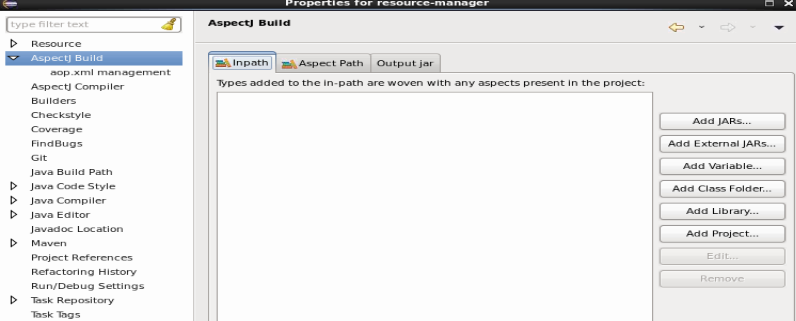Hi Andy!
Yes now I got the message 😊
I have exactly the same code. I think it has something to do with the compile and execution of my test case. I can see that ajc i done:
aspectj-maven-plugin:1.10:compile (compile_with_aspectj) @ resource-manager ---
[INFO] Showing AJC message detail for messages of types: [error, warning, fail]
[WARNING] invalid Class-Path header in manifest of jar file: /repo/eraonel/.m2/repository/org/restlet/jse/org.restlet/2.3.3/org.restlet-2.3.3.jar
invalid Class-Path header in manifest of jar file: /repo/eraonel/.m2/repository/org/uncommons/maths/uncommons-maths/1.2.2a/uncommons-maths-1.2.2a.jar
<unknown source file>:<no line information>
[INFO] Join point 'method-call(......)
However when I try to execute my test case I try to do it within Eclipse.
I have a 'Run configuration' for m2build making:
mvn clean compile
Then I have another 'Run configuration', testng, for my Demo test.
I execute it using a suite file that I have pointed out in Eclipse.
Is there anything that is different if I execute from within Eclipse?
br,
//mikael
Hey, hope you get this email :)
Here is a complete program:
==== 8< ==== 8< ==== Demo.java =========
public class Demo {
public static void main(String []argv) {
new Demo().test();
}
public void test() {
Node node = new Node();
Handler handler = node.getObjectHandler();
//getBoards() is the deprecated method.
Boards boards = handler.getBoards();
}
}
aspect X {
pointcut deprecatedMethods() : call(public * *(..)) && @annotation(Deprecated);
before() : deprecatedMethods() {
System.out.println("Caller: "+thisEnclosingJoinPointStaticPart.getSignature());
System.out.println("Called: "+thisJoinPoint.getSignature());
}
}
==== 8< ==== 8< ==== Demo.java =========
ajc -1.8 Demo.java
java Demo
Caller: void Demo.test()
Called: Boards Handler.getBoards()
You could use a declare warning to achieve some of this but I don't think it includes the enclosing join point as a key insert right now (see declare warning in
https://eclipse.org/aspectj/doc/released/README-169.html ).
Using declare warning means you'd see the message at compile time and not runtime.
|
It is now possible to ITD member types. The syntax is as would be expected. This example introduces a new member type called Inner into type Foo: public class Foo ...
|
cheers,
Andy


